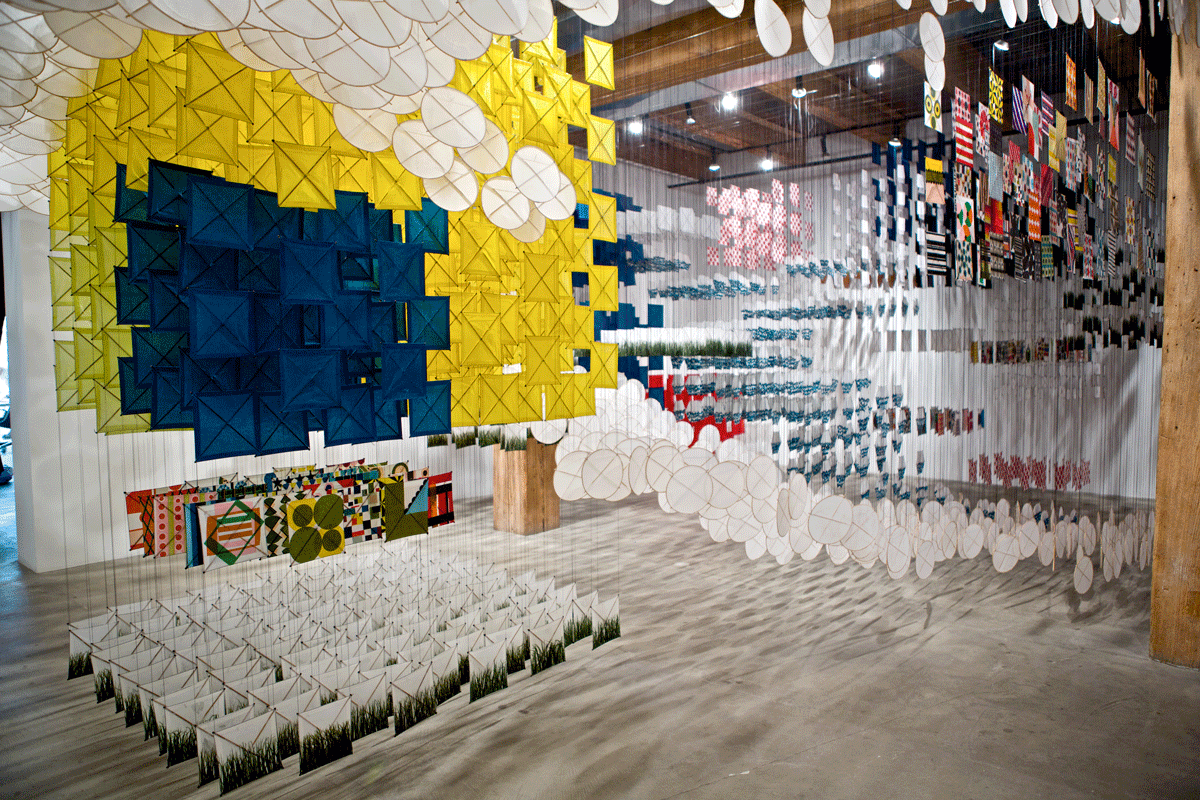
“Gas Giant,” (2012). Paper, bamboo, thread. Dimensions vary. Courtesy the artist. Photo: Cesar Arredondo.

“Sky Columns,” (2013). Paper, bamboo, acrylic, Dacron. Dimensions vary. Courtesy the artist. Photo: Cesar Arredondo.
[](#)[](#)
Jacob Hashimoto
Can You See My Veins Through this Marble Slab?
Twenty years ago, in the throes of a creative block, artist Jacob Hashimoto was gazing at a cluster of handmade bamboo and rice paper kites he’d strung from wires in his studio—a hobby of his at the time—when it dawned on him that he was looking at his next artistic medium.
“I realized I could use these paper objects and build fields out of them,” he says. “I could expand the pictorial space into a physical space. I could address it in a kind of language that no one had really done before.”
He’s since built an internationally recognized career creating elaborate works and installations with thousands of the small and carefully suspended geometric structures. Like a Monet painting or a school of miniscule, iridescent fish, the many tiny pieces that make up his works offer two visual experiences, depending on the proximity of the viewer: From afar, they’re looming, illumined, color-blocked masses reminiscent of the exterior of Disneyland’s “It’s a Small World” ride; up close, each piece is intricate, delicate, and often patterned and/or multi-colored.
Many of the New York-based artist’s ideas originate, at least in part, from his interest in video games. “Video games have always been a start reference for me in building pictorial space. If you look at \[my\] wall-based works, there’s a very strong sense of scrolling video game architecture, like early Mario Brothers.”
A case in point: His latest project for the MOCA Pacific Design Center in West Hollywood. Hashimoto is currently working on the last iteration of an installation for the museum called Gas Giant, which he conceived of while playing the sandbox indie game Minecraft. “I was interested in the idea that they were creating landscapes out of modules that they were stacking on top of each other.” Though Hashimoto co-opted some of Gas Giant from a computer screen, the realization of his vision is an astounding field of white and patterned cube-based clouds and multicolored waterfalls. It is a videogame come to life, through the painstaking assembly and positioning of about 30,000 paper kites.
It’s the intersection of the past and future that intrigues Hashimoto—old world mediums used to construct futuristic pieces. Particularly, he is fascinated by the tension between organic materials and digital designs. In addition to crafting kites, for several years he experimented with what he calls “water blocks,” or digitally manufactured water sculptures. Next, Hashimoto is working on black marble versions of his water blocks to show at the Mary Boone Gallery in New York City next year. He says he hopes the visual contrast between the traditional medium of marble, and the digital look of the sculptures, will result in an intriguing sort of artistic paradox. “They read like 3D models and then you see that they’re imperfect,” he says. “There are things you can’t control like the veins and the striations through the marble.”
For Hashimoto, each of his works offers an opportunity to relate and connect, and that’s an important facet to him. “If you’re interested in narratives, there \[are\] ways to create narrative. If you’re interested in abstraction, that exists there too. If you’re interested in childhood or nostalgia, they’re very evocative of those things,” he says. “I’m creating a platform through which viewers can bring their own experiences.”
